Carlos Soria: "The dream of the University of Navarra was to erect buildings with life, scale and human dimensions".
'Las casas del Campus de la Universidad de Navarra' tells the story of the 26 current buildings, "an architectural laboratory of signature buildings".

FotoPabloVillar/Professor and journalist Carlos Soria with photographer Manuel Castells, author of most of the images in the book.
15 | 06 | 2023
The professor and journalist Carlos Soria has just published Las casas del Campus of the University of Navarra (EUNSA). The work tells the story of the planning of the campus of Pamplona and its current 26 buildings, and includes, through 332 pages and 8 chapters, 415 images taken mostly by photographer Manuel Castells. The edition of the text is by Manuel Vieira da Cruz and the design of the pages, maps and infographics has been made by Errea Comunicación.
"As I began writing it - more than a year and a half ago - I was struck by a very suggestive idea of the French philosopher Gaston Bachelard: 'Every really inhabited space carries as its essence the notion of a house.'" Thus, the book alights on the 26 houses that have been built at Campus over 65 years. "The dream of the University of Navarra was to erect buildings with life, scale and human dimensions. Spaces for living together, territories where university students move in freedom and find themselves in peace."
The text has similar characteristics to the author's previous work, The Campus of the University of Navarra (2021), focused on gardens. "They are complementary books. The University is at the same time a large garden - the largest park in Pamplona - and a Campus of author's buildings, different from each other, unified by a large green carpet."
To date, the "houses" have been designed by more than 40 architects. Between 1958 and 1967 the authors of the buildings were Víctor Eusa, Ignacio Araujo and Juan Lahuerta, and the engineer and painter Fernando Delapuente. Around 1968, the University -which already had the School of Architecture- began to rely on other architects for the design of the new houses. "All of them, within the plan of needs set by the University and the budgetary limits, had absolute freedom of creation. The Campus thus became an architectural laboratory , a Catalog of independent creations, anchored in large open spaces, without excessive concern for how they fit into the whole," says Carlos Soria.
Houses that hold stories and objects: a 14th century Christ, a Sorolla or a 'Mallorca' ship's camera.
Of the 26 existing buildings, the book focuses in particular on ten: Clínica Universidad de Navarra, Cima, Sciences Building, Central Building, university dining hall, , School of Architecture, School , Main Library, Amigos Building and Museo Universidad de Navarra.
Manuel Castells, author of most of the images, explains that about 5,000 new photographs were taken over the course of a year, from which about 20 were selected per building. "On many occasions, a photographer's eye captures moments and details that other people don't usually notice. And after many years working at Campus, as is my case, the eye is accustomed to capture them more easily," says Castells.
The houses of the University of Navarra's Campus is also a book of stories. "As we fly over the houses-crossing the times-the stories appear. They are short stories, informative fragments evoked by the buildings, corners and physical objects found inside," says the author.
Both the University of Navarra Museum and the Science Museum or the Main Library keep "real wonders", according to the journalist. However, the book has focused on another 90 objects that, perhaps for the first time, are described in detail and their history is told.
Among them are a Lignum Crucis; a Christ Spanish from the XIV century; Italian and Spanish bargueños from the XVII century; the Immaculate Conception by Francisco Pacheco; the Image of the Virgin that presided over the beginnings of the University of Navarra in 1952; the 24-hour zodiacal clock from Central Building; a camera from the ship Mallorca (1914-1973); the laboratory of work of the photographer José Ortiz Echagüe; a department of a Renfe train carriage; a Sorolla, the Gold Medal of Navarre; the academic vestments of Saint Josemaría Escrivá de Balaguer; collections of clocks, jades, unusual musical instruments, etc.
The book is dedicated, the author points out, to the men and women who have collaborated in the construction of these houses -architects, engineers, workers and specialists-, "without forgetting those who have generously provided the economic means to build them (individuals, association of Friends of the University of Navarra, foundations, alumni, etc.) and those who with their discreet work have taken care -and continue to take care- of their maintenance and the luminous dignity of their cleanliness".
